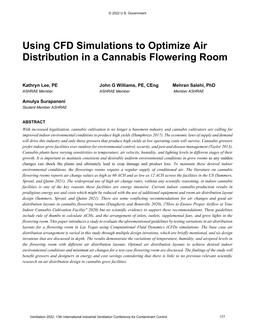Click here to purchase
With increased legalization, cannabis cultivation is no longer a basement industry and cannabis cultivators are calling for improved indoor environmental conditions to produce high yields (Humphreys 2017). The economic laws of supply and demand will drive this industry and only those growers that produce high yields at low operating costs will survive. Cannabis growers prefer indoor grow facilities over outdoor for environmental control, security, and pest and disease management (Taylor 2013). Cannabis plants have varying sensitivities to temperature, air velocity, humidity, and lighting levels in different stages of their growth. It is important to maintain consistent and desirable uniform environmental conditions in grow rooms as any sudden changes can shock the plants and ultimately lead to crop damage and product loss. To maintain these desired indoor environmental conditions, the flowerings rooms require a regular supply of conditioned air. The literature on cannabis flowering rooms reports air change values as high as 60 ACH and as low as 12 ACH across the facilities in the US (Summers, Sproul, and Quinn 2021). The widespread use of high air change rates, without any scientific reasoning, in indoor cannabis facilities is one of the key reasons these facilities are energy intensive. Current indoor cannabis production results in prodigious energy use and costs which might be reduced with the use of additional equipment and room air distribution layout design (Summers, Sproul, and Quinn 2021). There are some conflicting recommendations for air changes and good air distribution layouts in cannabis flowering rooms (Daugherty and Bonnville 2020), (“How to Ensure Proper Airflow at Your Indoor Cannabis Cultivation Facility” 2020) but no scientific evidence to support these recommendations. These guidelines include rule of thumbs to calculate ACHs, and the arrangement of inlets, outlets, supplemental fans, and grow lights in the flowering room. This paper introduces a study to evaluate the aforementioned guidelines by testing variations in air distribution layouts for a flowering room in Las Vegas using Computational Fluid Dynamics (CFD) simulations. The base case air distribution arrangement is varied in this study through multiple design iterations, which are briefly mentioned, and six design iterations that are discussed in depth. The results demonstrate the variations of temperature, humidity, and airspeed levels in the flowering room with different air distribution layouts. Optimal air distribution layouts to achieve desired indoor environmental conditions and minimum air changes for a test case flowering room are discussed. The findings of the study will benefit growers and designers in energy and cost savings considering that there is little to no previous relevant scientific research on air distribution design in cannabis grow facilities.
Product Details
- Published:
- 2022
- Number of Pages:
- 9
- Units of Measure:
- Dual
- File Size:
- 1 file , 4.2 MB
- Product Code(s):
- D-IIVC2022-C026
- Note:
- This product is unavailable in Russia, Belarus
